Please use the following link to download the October 27, 2018 issue of the syəcəb:
https://www.dropbox.com/s/h0sunkxfmycaekh/October%2027%202018%20sy%C9%99c%C9%99b.pdf?dl=0
syəcəb
Please use the following link to download the October 27, 2018 issue of the syəcəb:
https://www.dropbox.com/s/h0sunkxfmycaekh/October%2027%202018%20sy%C9%99c%C9%99b.pdf?dl=0
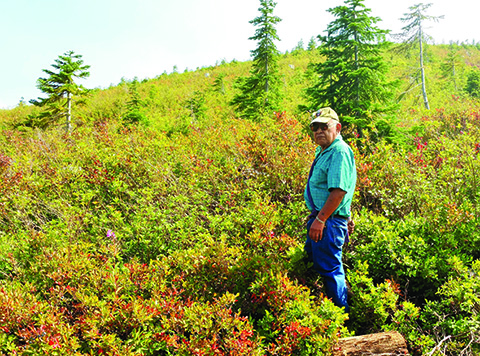
By Micheal Rios, Tulalip News
The Harvard Project’s Honoring Nations program has announced the selection of 18 semifinalists for the 2018 Honoring Nations awards. Among those selections are a variety of outstanding programs exemplifying self-governance and resource management, which includes the Tulalip Tribes ongoing demonstration of sovereignty through stewardship.
Honoring Nations identifies, celebrates and shares excellence in Native American tribal governance. At the heart of Honoring Nations are the principles that tribes themselves hold the key to generating social, political, and economic prosperity and that self-governance plays a crucial role in building and sustaining strong, healthy tribal nations
Since 1999, Honoring Nations has endeavored to spotlight successful governmental programs across Indian Country. This year’s applications included nearly 70 outstanding tribal programs representing 51 tribes. Of these, 18 were selected as semifinalists. These programs have demonstrated incredible impact in their communities, evidenced by their effectiveness, significance to sovereignty, cultural relevance, transferability, and sustainability – the criteria by which Honoring Nations assesses applicant programs.*
“Each year we are blessed with the gifts of Indigenous peoples’ resilience and perseverance reflected in their response to the challenges our people and nations face. They rise to the same levels as our forefathers did in their time to define the inheritance of the next generation,” stated Regis Pecos, Chairman of the Honoring Nations Board of Governors. “We are proud to share their wisdom and their vision.”
swədaʔx̌ali: Sovereignty through Stewardship”
Tribal communities in the Pacific Northwest have long-standing relationships to ancestral lands now managed by federal land management agencies. Generally speaking, during the centuries before colonial expansion, Indigenous peoples were profoundly connected with their natural surroundings. These cultures approached the natural world with an attitude of reverence and stewardship rather than dominion. In recent years, federal and state governments have increasingly recognized tribal rights to cultural resources on public lands and to participate in their management.
In the summer of 2009, three Tulalip staff accompanied the Skykomish District Ranger to a remote high elevation area of the Mt. Baker-Snoqualmie National Forest (MBS). This 1,280-acre area located 5,000 feet up in the mountainous highlands is now referred to as swədaʔx̌ali, a Coast Salish Lushootseed word for ‘Place of Mountain Huckleberries’.
“Over the last seven years, since the area’s formal designation, Tulalip has guided the management of this special area based on tribal values and ecological knowledge, and in direct support of the treaty, cultural, spiritual, subsistence and educational needs of our membership and our future generations,” explained Libby Nelson, Senior Environmental Policy Analyst for Tulalip’s Treaty Rights Office. “For example, rather than allowing continued encroachment of conifers that would eventually shade out huckleberries and other associated plants, Tulalip staff will remove many of them to stall natural succession in certain areas at swədaʔx̌ali. This will allow us to maintain productive berry fields and other cultural plants of importance, and enhance habitat for wildife that forage in open meadows.
“The swədaʔx̌ali co-management area did not happen easily or overnight,” continued Libby. “Instead, it was the result of a committed and sustained effort initiated by Tulalip to get the attention of our federal trustee, the U.S. Forest Service. Dialogue over three years culminated in the signing of the first tribal Memorandum of Agreement (MOA) on the Mt. Baker-Snoqualmie National Forest in 2007. As our relationship with the Forest Service grew under our MOA, so too did the breadth of projects undertaken.”
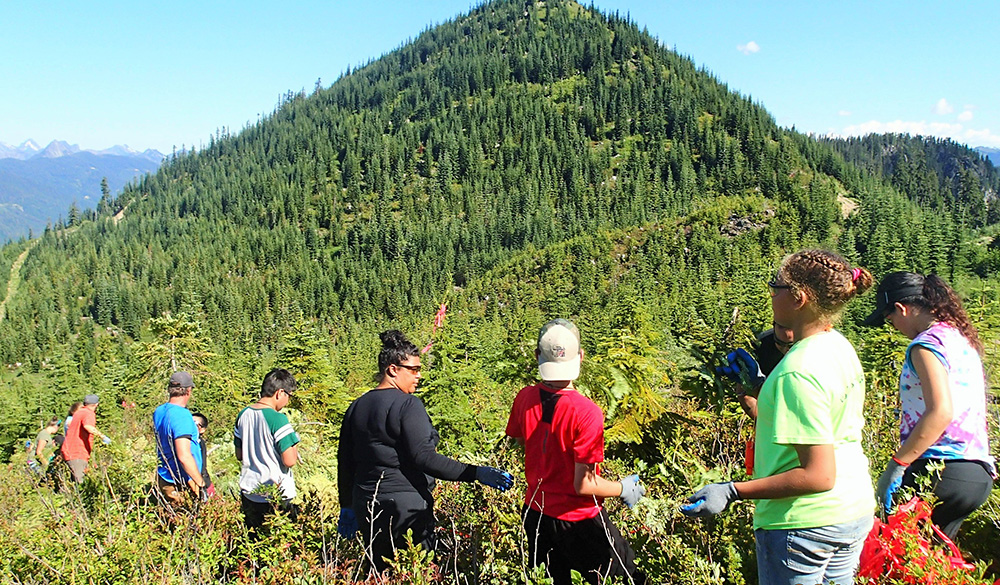
Tulalip Mountain Camp began in 2015, providing an annual weeklong, overnight natural resources and culture camp for middle-school tribal youth at σωəδαʔξ̌αλι This outdoor program seeks to connect youth to nature in a remote setting, teach them about their ancestral lands in the mountains, and engage directly with elders and our natural resources staff in huckleberry enhancement. This camp program has had a very positive impact on youth participants, as measured by camper surveys, feedback from families, and the significant number of return campers each year.
This initiative at swədaʔx̌ali is not only relevant to Tulalip culture, but is designed specifically to help sustain it. Continuation of tribal lifeways is dependent on having the resources that support these lifeways, access to them, and opportunities to transfer tribal knowledge and traditions to our youth. The 1,280-acre mountain area that constitutes σωəδαʔξ̌αλι, offers not only a diversity of habitats, plants and animals, but also remoteness, solitude and a relatively pristine environment needed for many cultural activities.
“We view our MOA and our work at swədaʔx̌ali as a strategic and dynamic government-to-government collaboration, with benefits directly proportional to the time and resources we invest in it,” reflected Libby. “The swədaʔx̌ali co-stewardship area most benefits Tulalip by providing an area for treaty gathering of high elevation resources, and for huckleberries in particular. It’s a place for our membership to connect to their ancestral mountain lands in a quiet, pristine, private setting, that is accessible to elders.”
The Harvard Project selected Tulalip’s ongoing stewardship of swədaʔx̌ali as a semifinalist for the 2018 Honoring Nations awards. As such, Tulalip’s commitment to stewardship is an active exercise in self-determination and implementing effective solutions to common governmental challenges in the areas of environmental research and resource management.
“Every day, tribal nations are solving complex issues in meaningful and effective way,” stated Director of Honoring Nations, Megan Hill. “Their work is inspiring, and holds examples for other governments, Native and non-native, to learn from.”
*Source: Honoring Nations press release, 3/28/2018
By Kalvin Valdillez, Tulalip News
Located on the corner of the Marine Drive and Water Works Road intersection is a small purple building next to the Tulalip Bay Fire Department. Inside the building is the workspace for a team of dedicated ladies who share the same goal of assisting the women, children and yes sometimes men as well, of Tulalip who are in or fleeing a domestic violence relationship, being stalked, or have experienced sexual assault. Since October is Domestic Violence Awareness Month, the ladies at the Legacy of Healing opened the doors of the purple building on the afternoon of October 18, to inform the community about what domestic violence is and what services they have to offer.
“We’re doing an open house so that people from the community can come in and see the building, so it’s not so intimating if they come in for services,” says Legacy of Healing Lead Advocate, Tiffany McLaughlin. “What we do is advocacy for victims and survivors of domestic violence, sexual assault, stalking, sex trafficking. We do legal aid and we have a therapist so we provide emotional support. And we can accompany them wherever they need to go to file papers, we’ll go to court with them and I can help with protection orders.”
According to the National Coalition Against Domestic Violence, nearly twenty people are physically abused by their partner per minute in the United States, totaling to more than 10 million victims each year. One in five women and one in seventy-one men have been sexually assaulted during their lifetime. And 5.1 million men and 19.3 million women have experience stalking, mainly by a former partner. Unfortunately, many people do not even realize they are in an abusive relationship because things haven’t escalated to a violent, physical level.
“A lot of people still have it in their minds that domestic violence is only physical,” says Legacy of Healing and Safe House Manager, Leora Jones. “They don’t think about the power in control, the verbal or mental abuse, and I know that because I was that person. When I first started working here I thought domestic violence was just physical; the verbal and mental abuse never even crossed my mind. Still to this day, a lot of people don’t even know that they’re in a domestic violence relationship. So the biggest thing our program has been working on is education and letting people know that you have support and we’re here to help you.”
“It doesn’t have to be an arrestable offense to be DV,” adds Tiffany. “Calling you names every day, being in control of all of your finances or giving you the keys to the car only at certain times like to pick up groceries, things like that. There doesn’t have to be physical proof for it to be abuse. If you find yourself changing your routine or avoiding doing something that you like because it makes your partner upset, like going to the gym, those could be red flags. And they might not show those signs at the beginning of the relationship, during the ‘honeymoon’ phase, they wait until you are emotionally attached and thinking, ‘they wouldn’t do this to me if they loved me’.”
As the afternoon progressed, the Legacy of Healing received plenty of foot traffic as community members dropped by to check out the open house. Guests were treated to a full tour of the building which includes a computer lab as well as a playroom for the kids. While attendees enjoyed a variety of snacks in the Legacy of Healing kitchen, they also purchased $3 raffle tickets for a chance to win a number of great prizes.
“Money raised from the raffle goes to support the women and children at the Safe House to provide them with personal care, personal hygiene items as well as gas gift cards and diapers,” explains Legacy of Healing Crime Victims Outreach and Training Coordinator, Dawn Augustus. “We’ll hold the raffle until the end of October and will hold the drawing on November 1. This year we are showcasing local artists Cy Fryberg, Marcia Horne, Kelly Moses, Patrick Ives and artists throughout the area who have generously donated their artwork for us.”
The Legacy of Healing works with the Tulalip Tribal Court system and receive referrals for survivors and victims of sexual assault and domestic violence. Legacy reaches out to let the victims know what services are available to them. They also take on self-referral cases to help community members who may be escaping a dangerous relationship.
If that’s the case, the women and children may benefit from staying at the Tulalip Safe House which houses between seventeen to twenty people at a time. The Safe House, as well as the Legacy of Healing, are safety zones, meaning that anyone whose been charged with domestic violence or sexual assault cannot enter the boundaries of that area. While at the Safe House, the survivors work with Safe House Coordinator Elizabeth Plowman, to work through their traumatic experience and prepare for the next chapter in their life.
“When you’re leaving a DV relationship you’re not leaving with access to the bank account or a car,” says Leora. “A lot of the women who come in don’t have prior job experience, they’ve been the stay at home mom. They work with Elizabeth and are able to get on TANF. Even clients who are no longer in the Safe House, still have access to that case management and advocacy from Elizabeth.”
A number of departments showed up in support of Legacy’s open house, including the Tulalip Bay Fire Department, Tulalip Community Health Department, Karen I. Fryberg Health Clinic and the Tulalip Police Department.
“I stopped by to see the resources they have,” states TPD Officer, Haison Doung. “The more resources we have, we can use while on duty and this is another great addition. The Legacy of Healing, the Safe House and the Child Advocacy Center do so much good for the community. To be able to show support is important because they give the victims all of these resources and that is important for healing.”
The Legacy of Healing has played an active role in this year’s Tulalip Unity Month and hosted a presentation, informing the youth about domestic violence. The department will continue making appearances throughout the community for the remainder of the month, helping spread awareness and education about domestic violence, stalking, sexual assault and trafficking.
“I hope that people take away that we’re friendly because domestic violence and sexual assault is not something that people want to openly talk about,” says Tiffany. “I hope that they can come in and feel comfortable and see that we’re not scary or judgmental, we’re just women who want to hold their hand and walk with them through this journey. Because most of us on our staff have been in a domestic violence relationship or are also survivors of sexual assault, we get it and we just want to be there for them.”
To help support the women and children of the Safe House, be sure to purchase a raffle ticket before the month ends. And for additional details, please contact the Legacy of Healing at (360) 716-4100.
By Kalvin Valdillez, Tulalip News
On a sunny autumn afternoon, a gathering was held outside of the Western States Petroleum Association building in Lacey, Washington on October 17. Many participants arrived wearing cedar hats and headbands and carrying traditional hand drums, as tribal members journeyed from around the state to show support of Initiative Measure No. 1631, an effort to charge pollution fees to large greenhouse gas emitters and conserve our natural resources for generations to come. As more and more participants arrived, they began to make signs to wave at local commuters who were taking a shortcut through an I-5 overpass. A number of small drum circles began to form and prayers were shared while they waited in anticipation for the I-1631 rally guest speakers to take the floor, including former Standing Rock Chairman, Dave Archambault and Quinault Indian Nation President, Fawn Sharp.
“Today we are here to raise awareness and to rally support around I-1631 right in front of the Western States Petroleum Association,” passionately expressed President Sharp. “They have sunk over twenty-two million dollars into their campaign to stop us but we are resilient, we are strong and we want to amplify our voice. We are confident that through our prayers and through the rich legacy of leadership throughout the ages, from the beginning of time to the end of time, we are going to be victorious on election day.”
As this year’s General Election date of November 6 draws nearer, it’s important to understand what I-1631 is and why it’s important for Northwest tribes. The initiative is a climate policy that imposes a fee on organizations that burn or sell fossil fuels, that includes motor vehicle fuel, natural gas and electricity. The measure is expected to generate over two-billion dollars within five fiscal years, beginning on January 1, 2020, and is set at fifteen dollars per metric ton of carbon content, or the carbon dioxide equivalent released from burning fossil fuels. This will increase by two dollars each year until 2035, putting the state on target to reach its 2035 and 2050 greenhouse gas reduction goals.
The monies generated from the carbon fee are prioritized as follows: 70% of carbon fees will go toward a new clean-energy infrastructure for Washington, utilizing clean, renewable energy, providing public transportation that uses cleaner fuels as well efficiency upgrades to homes and businesses to help save money on utilities; 25% of funds from the measure will go toward clean water and healthy forests, ensuring our forests are well taken care of and can protect the air quality, clean-up polluted lakes and rivers, increase the amount of drinking water and ensure cleaner water for salmon; and the remaining 5% will be invested into the local communities, preparing for any future problems that may arise due to climate change.
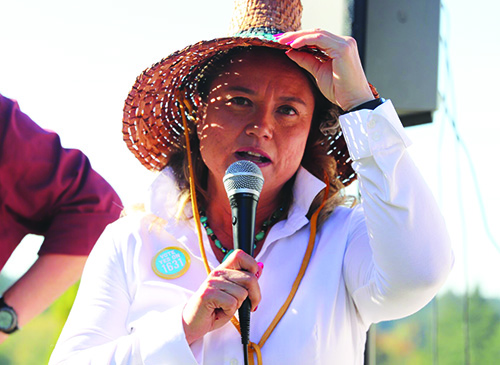
“I-1631 is a specific climate policy tribes’ gathered over the last year and a half,” says Fawn. “Quinault has been working on this initiative for well over two years and we’ve been working on climate policy for about twelve years. It was very clear to us that we’re not going to achieve climate policy in Olympia, it’s not going to happen in Washington D.C., but we were also confident that the average citizen understands the role of tribes as leaders.
If you look to Lummi at Cherry Point or Quinault fighting crude oil in Grays Harbor, the average citizen understands our treaties are the last line of defense to keep corporations out and from continuing to exploit our natural environment. We pulled all those resources together, the brain trust of Indian Country, our scientists, our lawyers, our tribal leaders and we adopted thirteen basic principles of climate policy that we knew were the minimum standards for us to effectively combat climate change.”
As the rally continued, tribal and community leaders from Tulalip, Quinault, Puyallup, Nisqually, Squaxin and several other sovereign nations shared their traditional songs as well as words of encouragement that got the crowd of over one-hundred I-1631 supporters hyped. Young Tulalip and Tsleil-Waututh Indigenous Activist, Cedar George-Parker, spoke to the youth about the importance of their voice and Earth-Feather Sovereign talked about MMIW (Missing & Murdered Indigenous Women), continuing to bring much needed awareness to the epidemic that is claiming the lives of our Native women. Dave Archambault journeyed from the Standing Rock Sioux Tribe to show his support of the initiative.
“For me, [I-1631] means the things that happened at Standing Rock lives on,” he says. “The effort that was put forth to protect Unci Maka, Mother Earth, wasn’t lost just because that one battle didn’t work out the way we wanted it to. The policy that fails us is consultation and 1631 is a way to address that and a way to assure that tribes have complicit consent when a project threatens their homelands or threatens their environment, threatens mankind or humanity. When tribes speak up, we will be heard and that’s transcends from Standing Rock and that’s what today means to me.”
I-1631 does in fact have a provision for the tribes of Washington state that requires any state agency to consult with tribes on any decisions that could directly affect the tribes, their land or their usual and accustomed fishing grounds. Projects that are funded or begin on tribal land without prior consultation will be forced to end upon request of the tribe. Keeping the tribe’s sovereignty at heart was the First American Project comprised of several tribal leaders and El Centro de la Raza, a Latino based organization that promotes unity amongst all races.
“The First American Project was originally founded when tribes organized to take out Slade Gordon and elect senator Maria Cantwell,” explains Fawn. “When it came time to organize for I-1631 we thought it would be a natural fit to revive something that worked so well for tribes in the past. We wanted not only to create space for tribal nations but also our partners like El Centro de la Raza who helped us during the fishing wars. It’s an exciting opportunity for us to join our communities that have worked effectively in the past. We view I-1631 as the first issue we are going to take up. We understand that there are many issues of our generation like immigration that we can partner with El Centro because I think tribal nations have something to say about immigration and separating children from families.”
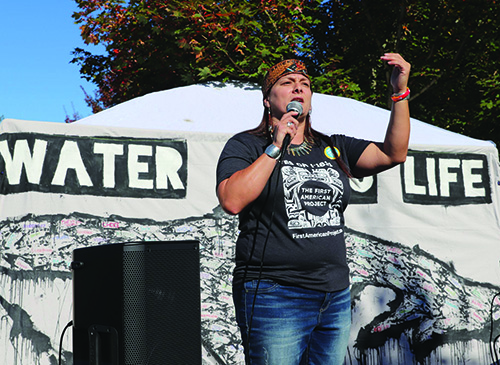
Tulalip tribal member and First American Project Board Member, Theresa Sheldon, took up emcee duties during the rally. She is also the project’s Campaign Chairwomen and has been tasked with informing and educating Native Peoples on why the initiative is important.
“It’s important for us because we’re the first ones who feel it,” Theresa states. “Native Peoples are like the canary birds in the coalmines, we’re the first ones to show signs of it not being safe. We’re already seeing that; we’re seeing that in gathering our cedar, gathering our huckleberries, we’re seeing the change in the seasons happen and the change in our plants. Sea level rise is already impacting our nations, look at Taholah, Queets and Hoh who have to relocate. They’re the first ones on the ocean so it’s already impacting them. Tulalip Tribes just did our climate change flood levels and in fifty years we’re looking at a lot of different areas of our reservation that potentially could be under water. That’s scary to think about, that will be during my lifetime so I’ll probably see that.
“It’s also important for Natives because carbon is what warms our water,” she continues. “Carbon pollution warms our Puget Sound and our rivers and that’s what’s impacting our fish. That results in not being able to have our fish, crab, our traditional foods. And once it’s gone, there’s no coming back. All the studies have shown that we’re the ones who can make the change, this generation has to make monumental changes. It has to be radical, it has to be fierce and intense changes, it can’t be to just stop using straws.”
Studies show that climate change is real and is currently happening at an alarming rate. If we continue to emit pollution into the environment, scientists predict that in a hundred years the world will frequently experience deadly, extreme heatwaves for days at a time. And if you think about it, one-hundred years isn’t that far away and the heatwaves are going to be something your great-great-grandchildren will have to live through. As Theresa pointed out, tribal lifeways are already being threatened by climate change, namely the Quinault Indian Nation’s villages of Taholah and Queets.
“This is important as Quinault tribal leader because we are right now facing an emergency situation where I’m having to relocate two of our villages to higher ground, the villages of Taholah and Queets,” says Fawn. “In my tenure as President of the Quinault Nation, I’ve seen it first hand, it’s created an unreal sense of urgency for me and we’re going to continue to fight this until we achieve those policies that we know are minimally necessary for us to defend ourselves and advance our future.”
If voters pass I-1631, the initiative will create over 40,000 jobs in the clean energy field, developing and maintaining renewable energy resources such as wind turbines. A number of big name supporters including Bill Gates and Pearl Jam recently expressed that they are in favor of the measure. And organizations such as Microsoft, Expedia, Union of Concerned Scientists and the American Lung Association are funding the initiative.
On the other side of the coin, Western States Petroleum has dug deep into their pockets and raised over twenty-five million dollars to run a slew of misleading TV ads against I-1631 claiming that the fee is ‘unfair’ to big oil. The opposition also wants you to believe that a large amount of companies are exempt from the fee, which is true to a degree if they are referring to coal burning factories or power plants that have been legally bound to close no later than 2025.
A real concern for undecided voters is that the cost of gasoline, electricity and natural gas is expected to rise as a result of the companies’ obligation to pay the carbon fee. However, funds raised from the fee will actually help Washingtonians transition into more of a clean energy lifestyle by utilizing renewable energy resources such as solar and wind power, so we’re not dependent on companies who are harming the environment.
“The power of our tribal communities is so remarkable and I firmly believe that when we come together, no matter what the issue, we’re unstoppable,” expresses Fawn. “When you look at this last year, we were victorious on the culverts case, we were victorious on eleven different treaty conflicts with the state of Washington. At any time, anyone or anything tries to attack us and we come together, we’re quite successful.
“We envision a clean, healthy future. A prosperous future where renewable energy, new technologies and new economies are going to be developed and you’re going to see an explosion of growth in Indian Country. The one thing I would like to tell the voters is to get out there and vote. If you’re not registered, register [by October 29] and make sure your voice counts on November 6.”
For more information, please visit www.YesOn1631.org
By Micheal Rios, Tulalip News
The Tulalip Heritage Lady Hawks have found their groove at the perfect time. After consecutive victories over Muckleshoot, Orcas Christian and Fellowship Christian, the Lady Hawks volleyball team was riding a wave of winning momentum into their final regular season game played on Monday, October 22, versus the Lummi Blackhawks.
It was “Senior Night” for 12thgraders Yesenia Araiza and Nancy Enick. Prior to the match, family and friends of both players took to the court with balloons and flowers to recognize the occasion.
“My family shows a lot of support all the time, but it still felt really great sharing that moment with them,” said Nancy.
“I felt sad at first realizing this would be my last home game here,” added Yesenia. “Having so many fans come out to support us made the night special and got me excited to play.”
With emotions running high and the bleachers full of cheering Tulalip fans, the Lady Hawks took to the court. In the opening game Nancy served her team to a 5-0 lead. Lummi battled back eventually tying the game at 14-14, but the home team wouldn’t be denied. Tulalip went on an 8-0 run to take a 22-14 lead and closed out the game 25-16.
In the 2ndgame, Lummi jumped out to a 6-3 lead. Freshman Jacynta Myles served up several aces to give the Lady Hawks a 12-7 lead. It would be a back forth game for several points, but the home team would close it out strong, winning 25-20.
Team captain Deachae Jones displayed her solid serving abilities in the 3rdgame. Behind her, Tulalip jumped out to an overwhelming 13-4 lead. Lummi was unable to muster a counter attack, yielding the final game 25-14 and giving Tulalip yet another win in straight sets.
Deachae spoke for her squad following the “Senior Night” victory by saying, “We’re looking forward to playing in Districts because every game we’re having fun and continue to improve.”
Now, riding a four match win streak, the Lady Hawks (8-6) are primed for a quality showing in the upcoming District playoffs. They’ve been seeded #6 in the playoff bracket and will be hitting the road to play games on October 24thand
Please use the following link to download the October 20, 2018 issue of the syəcəb:
https://www.dropbox.com/s/htinix5gbnxxly9/October%2020%202018%20sy%C9%99c%C9%99b.pdf?dl=0
By Micheal Rios, Tulalip News
Thirty years ago, you couldn’t find a map using the term “Salish Sea” for the Puget Sound region. There were Seattle galleries and souvenir shops aplenty selling Native art, but the masks, totem poles and sinuous formline animal prints were designs from hundreds of miles away, not from here.
Thirty years ago, no major art museum in Washington had mounted an exhibit highlighting Native created works of our own lands and waters. Salish artists were indeed honing their skills and creating beautiful works of art, but the critical interest and most gallery attention was focused on art from Alaska and the Canadian coast.
In 1989, the balance started to tip. Washington’s Centennial exhibit of Native arts opened, managed by Patricia Cosgrove and Kenneth Watson. Both art historians were on a mission to convince Washingtonians that totem poles are not indigenous to this area and that Salish art is. The exhibit was incredibly successful, and soon many influences aligned to literally change the landscape of the Northwest Native art market.
Ever since, the diligence and commitment of so many artists and their allies has led to the word ‘Salish’ entering mainstream vocabulary. This insured the characteristic sweeping lines and subtle patterns of Salish arts remains recognizable and emblematic of the greater Seattle area.
Through the effort of many, this vision has come true. High quality galleries like Seattle’s Stonington Gallery and Steinbrueck Native Gallery feature experienced and rising artists from across the Salish Sea region. Generations of new artists have risen in skill and popularity. Today, Salish art is an explosion of innovation and creativity that still has a firm foundation in our region’s heritage.
That innovation and creativity of Coast Salish artistry is currently on full display at the Mobius Art Gallery, located in Bothell on the Cascadia Community College campus. Inside the gallery mounts an unprecedented five-week long exhibition titled Native Spirit: Art from Indigenous Cultures.
“The artists and artwork in this exhibition embody a wide range of spirit and narratives that live within their Native cultures,” stated exhibit curator Chris Gildow. “Their skills, creativity, and passions are equaled only by their commitment to breathe life into artwork they create. Their artwork tells us about the connection between human and animal worlds, about salvation and transformation, and about our relationship with the Earth. This exhibition lets us share these stories and traditions with the entire community.”
On Tuesday, October 9, the auditorium adjacent to Mobius Art Gallery was filled with excited art enthusiasts and college students who heard there would be a traditional Native American welcome ceremony to mark Native Spirit’s grand opening. Led by Ray Fryberg, the Tulalip Canoe Family filled the auditorium with traditional song and dance to commemorate the special occasion.
Eight artists were selected to be showcased in the Coast Salish themed exhibit, which includes handcrafted submissions by five talented Tulalip tribal members: Mike Gobin, Tillie Jones, Ty Juvinel, James Madison, and the artist known as Cedar.
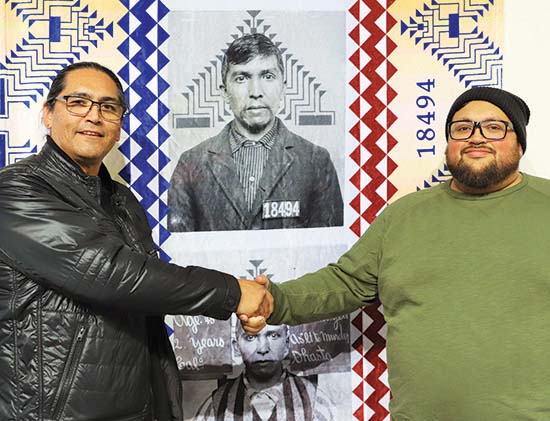
“It shows there’s a lot of talent in Tulalip,” said art gallery contributor Ty Juvinel. “We’ve grown a lot as artists. Seeing all the different artwork and local artists represented here is awesome.”
“I met the curator of this exhibit, Chris Gildow, about a year ago when he asked me about a Salish exhibit that he wanted to put on here at Cascadia College,” added Lower Elwha artist Alfred Charles, Jr. “As artists, he gave us free reign to create whatever we wanted. I’m excited that so many people came out and shared their art with the community. This exhibit turned out great.”
Coast Salish art is rich in its diversity of forms. Masks, weavings, wood carvings, jewelry, and intricate bead work are but a few of the common mediums often associated with the Coast Salish style. Subject matter includes, but is not limited to, human and animal forms, spiritual themes and mythic figures. A diverse selection of artwork was chosen to be on display.
Native Spirit: Art from Indigenous Cultures will be on display until November 15. Mobius Art Gallery is open and free to the public Monday – Thursday, 10:00am to 4:00pm. For more information please visit www.cascadia.edu/nativespirit
By Kalvin Valdillez, Tulalip News
On the morning of October 12, the Betty J. Taylor Early Learning Academy (TELA) gymnasium was occupied by tiny future leaders who sat crisscross apple sauce while listening to the Killer Whale story told by a team of nine Lushootseed Language Teachers. In addition to stories, the teachers also performed a number of traditional songs, receiving plenty of crowd interaction as the youngsters knew many of the words and happily sang along in Lushootseed. This joyful gathering was just the first of many upcoming Cultural Days where the students attend an assembly in the morning and create crafts in the afternoon, all while learning about the traditional lifeways of the Tulalip people.
“The second Tuesday of every month we are having a Cultural Day during a full day of school,” explains TELA Montessori Manager, Tami Burdett. “We start with a cultural assembly and invite the families and then we do a cultural craft in the classrooms. We teamed up with the language department and it was wonderful because the kids know these songs and they proudly sing them.”
This year TELA has implemented a language immersion curriculum, partnering with the Lushootseed language department to teach the revitalized Coast Salish vocabulary to the kids. Every day the language warriors pay a visit to the classrooms, sometimes leading the class by sharing stories and songs in Lushootseed, other times simply interacting with the kids and speaking the language to them individually during playtime or lessons.
Studies have shown that kids soak up the most knowledge during early childhood development, making the expression ‘a child’s brain is like a sponge’ seemingly true. Families of other cultures have proven that kids can learn to fluently speak two languages at a young age, speaking their native tongue at home and English while at school or with friends. More importantly, TELA is proving that right now with the language immersion approach, ensuring Lushootseed lives well into the future.
Cultural Day takes the traditional teachings and the language immersion idea to a new level. Each assembly features local guest speakers who offer their stories and teachings to the students. The half hour assembly is followed by cultural crafts. Once the kids return to their classrooms, they participate in a hands-on traditional art project.
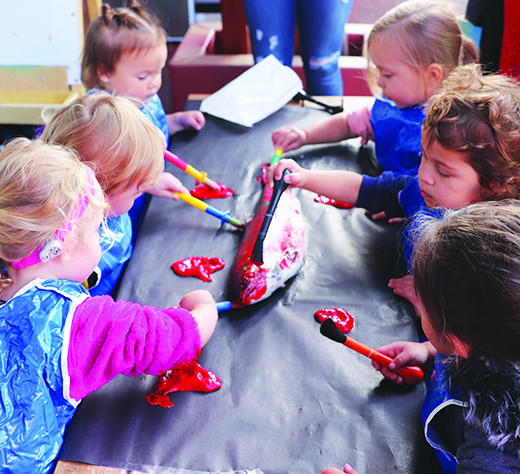 “Each of the classrooms are going to be doing a fish print today,” says Tami. “Once completed those will be going home with the kids to share with their families. It’s actually really neat, they take the salmon and paint it and then they take the fish and put in on fabric and you have a beautiful fish print. We’ve known many families that frame their kids’ fish prints and display them at home.”
“Each of the classrooms are going to be doing a fish print today,” says Tami. “Once completed those will be going home with the kids to share with their families. It’s actually really neat, they take the salmon and paint it and then they take the fish and put in on fabric and you have a beautiful fish print. We’ve known many families that frame their kids’ fish prints and display them at home.”
Many TELA teachers use craft time as an opportunity to expand their lesson plan and teach the kids the cultural significance the craft has to Native communities. For instance, as her students covered their fish in red paint, TELA teacher Alix McKiernan asked them a few questions about salmon, like where do salmon live and if they liked to eat salmon. After the kids responded, Alix added a number of ‘did-ya-know?’ facts about the relationship between salmon and Northwest tribes and also asked the students if they’ve ever caught a salmon or went fishing with their families. 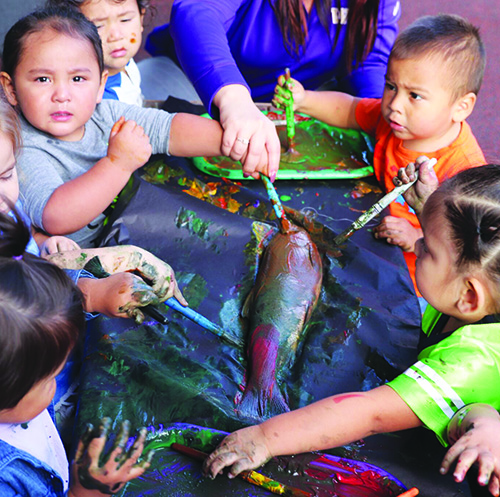
After their prints were finished, Alix’s classroom was treated to more interactive education as she cut open the salmon so the kids could get an up close look at the anatomy of the fish.
TELA’s next Cultural Day will be held on November 13, and families are welcome to join and watch Tulalip’s future generation learn their ancestral teachings to strengthen the culture for years to come.
“It warms my heart to hear the children sing and speak the language and to see them so excited to learn about our culture,” Tami expresses. “[At future Cultural Days,] the boys will be making drums with their families and the girls will be making clappers. Those will follow them until they graduate and then they get to take them home and use them to practice and perform. The kids love the songs and the language, even when we welcome them into the school every morning we hear ηαʔɬ δαδατυ ανδ ηαʔɬ σψəψαʔψαʔ in the afternoon. We love hearing the language.
“We would like to send a big shout out to Brandon Carrillo for donating fish; Ms. Kris who coordinated with her brother-in-law, Steven Young, from fisheries, they donated nine salmon. And also, Rudy Madrigal, who bought twelve fish from our fishermen and donated them to [TELA Policy Council Chair] Mike Pablo for us.”
For more information about Cultural Day, please contact the Betty J. Taylor Academy at (360) 716-4250.